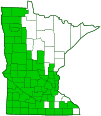Plains garter snake
(Thamnophis radix)
Conservation • Description • Habitat • Ecology • Distribution • Taxonomy
Conservation Status |
|||
| IUCN Red List | LC - Least Concern |
||
| NatureServe | N5 - Secure S5 - Secure |
||
| Minnesota | not listed |
||
Description
Plains garter snake is a medium-sized, nonvenomous, typical snake. It can be from 14″ to 43″ long at maturity, though it is usually no more than 28″ in length. Females are slightly longer and significantly heavier than males.
The background color is variable and may be light brown to black or olive green. There are three pale stripes that run the length of the body. The central stripe is usually bright yellow or orange, sometimes orange near the head and then yellow to the tail. The lateral stripes are cream-colored to pale yellowish, and are on the third and fourth scale rows counting up from the belly (ventral) scales. There are two rows of alternating black spots on each side between the central and lateral stripes. The spots may be prominent and invade the stripes, or may be obscured on dark colored individuals. Red skin may be visible between the scales when it stretched over recently consumed prey, but there are no red scales. At mid-body there are 19 to 21 rows of scales. The upper (dorsal) and lateral scales have a narrow raised ridge (keel) along the centerline.
The belly is white and may be tinted yellowish or bluish. There is usually a row of small black spots at the ends of the ventral scales. These spots are partially hidden by overlapping ventral scales. The anal plate is not divided. Underneath the tail there are two rows of scales (subcaudal scales).
The head and neck are uniformly dark usually with a pair of yellow spots. All of the scales above the mouth (labial scales) are the same color as the lateral stripe and usually all of them have a bold black border.
Size
Total length: 14″ to 43″
Similar Species
Eastern garter snake (Thamnophis sirtalis sirtalis) lateral pale stripes are on the second and third scale rows counting up from the ventral scales. None or at most one or two of the labial scales have a bold black border.
Lined snake (Tropidoclonion lineatum) is much shorter, only 8″ to 12″ long at maturity. The 3 stripes are off-white. There are 2 rows of dark, half-moon marks on the belly. In Minnesota it has been found only in Blue Mounds State Park.
Habitat
Moist, open places. Prairies, meadows, farmlands, and other open areas near water.
Ecology
Behavior
Lifespan
5 to 10 years
Life Cycle
Overwintering Plains Garter Snakes emerge from their overwintering sites in March. Females reach sexual maturity in 2 or 3 years. Breeding takes place in April or May. Gestation takes 83 to 102 days. In July to September the female gives birth to a litter of 4¾″ to 9½″ long, live young. The litter size is usually 10 to 20 but may be as few as 5 or as many as 60. The young are on their own from the day of their birth.
In late October they gather in large numbers, sometimes with other species of snakes, in rodent burrows, abandoned ant mounds, or under sidewalks, to overwinter. As the temperature drops they enter a state of suspended animation (brumation).
Food
Earthworms, amphibians, leeches, slugs, snails, insects, crayfish, small fish, bird eggs, mice, other snakes, and carrion.
Toxicity
Plains garter snakes are venomous but their venom is not strong enough to cause serious harm to humans. Allergic reactions to a bite from a Common Garter Snake are rare. Reaction to a bite is normally little more than swelling and irritation around the puncture wound. However, like a bite from any animal, bacteria from the mouth of the snake can cause an infection.
Distribution |
||
|
Sources Biodiversity occurrence data published by: Minnesota Biodiversity Atlas (accessed through the Minnesota Biodiversity Atlas Portal, bellatlas.umn.edu, 10/26/2025). |
|
| 10/26/2025 | ||
Occurrence |
||
Common |
||
Taxonomy
Class
Reptilia (Reptiles)
Superorder
Lepidosauria
Order
Squamata (Snakes and Lizards)
Suborder
Serpentes (Snakes)
Infraorder
Alethinophidia
Superfamily
Colubroidea
Family
Colubridae (Harmless Egg-laying Snakes)
Subfamily
Natricinae
Genus
Thamnophis (garter snakes)
Subordinate Taxa
Synonyms
Eutaenia haydenii
Eutaenia radix
Eutaenia radix twiningi
Eutainia haydenii
Eutainia radix
Thamnophis radix haydenii
Thamnophis radix radix
Common Names
eastern Plains Garter Snake
Plains Garter Snake
Glossary
Anal plate
In snakes: the large scale in front of and covering the anus. In turtles: one of the posterior plates of the lower shell (plastron). In Lepidoptera: the often hardened shield on the dorsal surface of the last (10th) segment of the abdomen.
Ventral scales
On snakes, the row of enlarged, elongated scales extending on the belly from the neck to the anal plate.
Visitor Photos
Share your photo of this reptile.
This button not working for you?
Simply email us at info@MinnesotaSeasons.com.
Attach one or more photos and, if you like, a caption.
Lane Keller |
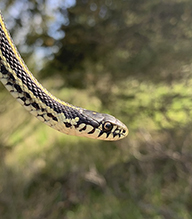 |
Found this near Prairie Lake on the trail. You are more likely to find this species during the spring and fall. |
Norm & Peg Dibble |
||
A good size Garter Snake showed up just off the patio and under the bird feeders in May of 2014. We watched a Garter Snake once go into the pond and swim around, stopping to go up to the edges slightly and smell with his long fork tongue, looking for frogs. He sniffed out one that was in the flowers near the stream’s edge. The frog must have panicked and jumped into the pond to his demise. The snake was on him in a flash. It took the snake a long time while resting at the back of the garden to ingest the frog. That was not a pleasant sighting, but that’s nature and the food chain. The grass in this area is a coarse grass and it was long that day, if that helps in assessing the size of the snake. One of the biggest ones I’ve seen in our yard. I was not standing by him, but inside at the patio door again. |
||
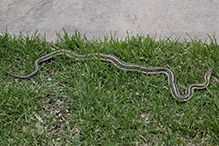 |
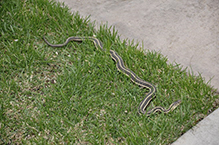 |
|
Bill Reynolds |
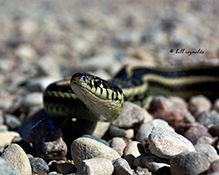 |
MinnesotaSeasons.com Photos
|

Slideshows

Visitor Videos
Share your video of this reptile.
This button not working for you?
Simply email us at info@MinnesotaSeasons.com.
Attach a video, a YouTube link, or a cloud storage link.
Other Videos
Plains Garter Snake (Colubridae: Thamnophis radix) Scale Pattern
Carl Barrentine
A Nature Video: Plains Garter Snake
JBtheProducer
The Plains Garter Snake (Colubridae: Thamnophis radix)
Carl Barrentine

Visitor Sightings
Report a sighting of this reptile.
This button not working for you?
Simply email us at info@MinnesotaSeasons.com.
Be sure to include a location.
Lane Keller
5/13/2022
Norm & Peg Dibble
May 2014

Location: Maple Grove, MN
A good size Garter Snake showed up just off the patio and under the bird feeders in May of 2014. We watched a Garter Snake once go into the pond and swim around, stopping to go up to the edges slightly and smell with his long fork tongue, looking for frogs. He sniffed out one that was in the flowers near the stream’s edge. The frog must have panicked and jumped into the pond to his demise. The snake was on him in a flash. It took the snake a long time while resting at the back of the garden to ingest the frog. That was not a pleasant sighting, but that’s nature and the food chain.
The grass in this area is a coarse grass and it was long that day, if that helps in assessing the size of the snake. One of the biggest ones I’ve seen in our yard. I was not standing by him, but inside at the patio door again.

